

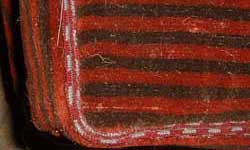
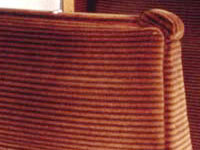 Dating from the early 1960s (possibly 1963, but maybe earlier), and used principally in smoking accommodation, red candy-stripe was used extensively across BR, as well as in Southern Region Bulleid stock. Usually used with the stripes horizontal, it was however used vertically on the AM10 (Euston-Northampton - later known as class 310) trains when new.
Dating from the early 1960s (possibly 1963, but maybe earlier), and used principally in smoking accommodation, red candy-stripe was used extensively across BR, as well as in Southern Region Bulleid stock. Usually used with the stripes horizontal, it was however used vertically on the AM10 (Euston-Northampton - later known as class 310) trains when new.
On the Bluebell it has been used in several coaches, since we have had a supply of this moquette from remnants, and seating units obtained which still carried this moquette. The photo on the right shows it as used in the Bluebell's Bulleid Open Third No.1482, and the page for Bulleid No.1464 has further photos.
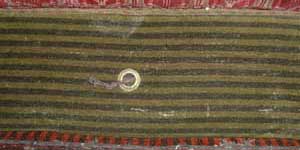 The "non-smoking" verson of the above, also used extensively across BR.
The "non-smoking" verson of the above, also used extensively across BR.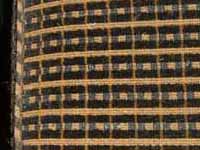
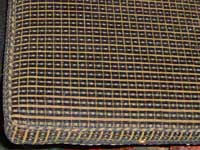 The first-class equivalent of Candy-stripe, page 143 of Parkin's book (1st ed) shows it new in 1960, and used in a retrim (probably) of Open First 3042 on p.82. This was the version used for smoking accomodation.
The first-class equivalent of Candy-stripe, page 143 of Parkin's book (1st ed) shows it new in 1960, and used in a retrim (probably) of Open First 3042 on p.82. This was the version used for smoking accomodation.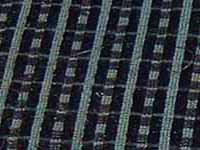
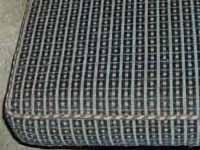 The non-smoking version of the above.
The non-smoking version of the above.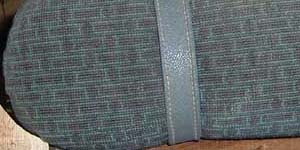 The first class seating of Bulleid CK 5768 carried this moquette when withdrawn from traffic in 1968. It features on page 78 of Parkin's book in a 1961 photo.
The first class seating of Bulleid CK 5768 carried this moquette when withdrawn from traffic in 1968. It features on page 78 of Parkin's book in a 1961 photo.
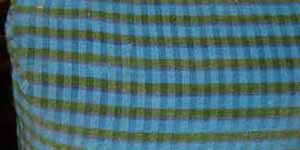 So-called since it was used extensively on the rebuilding of steam-hauled Mk.1 stock as REPs and TCs for the Bournemouth electrification in 1966-7 and subsequently much used in CIGs and VEPs and other BR(S) electric units. A photo (plate 133 lower) in Marsden's 1948-1983 EMU book shows a TC second class compartment trimmed with this moquette.
So-called since it was used extensively on the rebuilding of steam-hauled Mk.1 stock as REPs and TCs for the Bournemouth electrification in 1966-7 and subsequently much used in CIGs and VEPs and other BR(S) electric units. A photo (plate 133 lower) in Marsden's 1948-1983 EMU book shows a TC second class compartment trimmed with this moquette.
This moquette was first used on the Mk.2 TSOs for the BR(M) West Coast electrification to London.
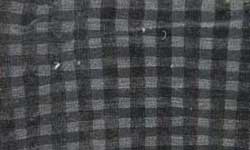
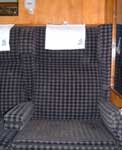 The first-class version of "Bournemouth Blue" was used on the Bournemouth Line stock (plate 133 upper in Marsden) and in re-trims of many Mk.1 coaches from the mid-late 1960s onwards. On the Bluebell, it is present in Mk.1 CK No.16210, since the trim in situ in the first-class compartments of this coach was good enough condition for further use.
The first-class version of "Bournemouth Blue" was used on the Bournemouth Line stock (plate 133 upper in Marsden) and in re-trims of many Mk.1 coaches from the mid-late 1960s onwards. On the Bluebell, it is present in Mk.1 CK No.16210, since the trim in situ in the first-class compartments of this coach was good enough condition for further use.
Plate 196 of Haresnape's Pullman book shows this BR moquette was also used in the 1968 refurbishment of Brighton Belle car Audrey.
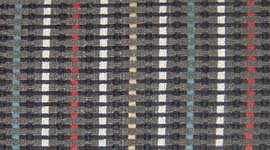
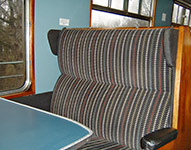 This ubiquitous later BR Moquette is widely associated with Mk.1 stock, and much preserved stock is trimmed with it. On the Bluebell is features in many carriages, including, as photographed here, Mk.1 RMB 1838.
This ubiquitous later BR Moquette is widely associated with Mk.1 stock, and much preserved stock is trimmed with it. On the Bluebell is features in many carriages, including, as photographed here, Mk.1 RMB 1838.
This page is part of the Carriage Technical Pages
Pages about Moquettes: Index - 1920s - 1930s - 1940s - 1950s - 1960s - Pullman